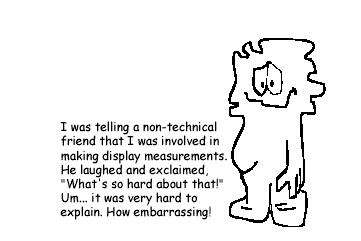LCD – For the Novice and the Expert
by Kristopher Kubicki on September 4, 2003 12:13 AM EST- Posted in
- Displays
Special Thanks

© VESA
We received an extraordinary amount of help from the following companies. We thank you very much for your expertise and dedication:
Samsung Electronics
LG.Philips
NEC-Mitsubishi
AU AUOptronics
Sharp
VESA
MonitorsDirect.com / Hitachi
Albatron / Monivision
And of course, our very own AnandTech forums for providing technical and general background on much of the information covered. Don’t forget to check out our second installment of this FAQ, which will feature in depth analysis of substrate modes and response times!










63 Comments
View All Comments
KristopherKubicki - Friday, September 5, 2003 - link
#42 - this will be addressed in Part II =)Kristopher
Anonymous User - Friday, September 5, 2003 - link
Very nice article. Easy to read, fun and very informative.However, as someone here stated earlier, the reference to how some companies manage to get more than the 262000 colours with the 16ms AUO substrate is missing. It seems that they do this by alternating two colours, which would in effect mean the actual total rise and fall time for that one colour is more than 16 ms. But perhaps this is to be discussed in the follow-up to the article? I'm really interested in reading about the grey-grey times for the panels, so I'll be looking forward to part II.
AbRASiON - Friday, September 5, 2003 - link
Wouldn't touch one until it beats a CRT in every single way - periodFor work yes, sure right now, one res all day, no games, no worries.
For home, multiple resolutions, more dos boxes - linux sessions (ok I don't have any but if I did) - games which I don't have a strong enough video card for native resolution etc etc.
also the stupid ghosting / shading effect of the high refresh (16ms is too high)
Until it beats a CRT in every single way - I'm not going over - EVEN IF CRT's end up costing more.
Plus CRT's are getting better, my 22" Philips (100hz 1600x1200) is only like 45cm deep - quite short really considering.
virtualgames0 - Thursday, September 4, 2003 - link
I think you missed a big issue with LCD image problems that I have commonly observed. Most LCDs are very dim, and almost all of them I've seen are nowhere close to comparable to a CRT, the only ones I've seen that were comparable was the NEC.Another problem I have commonly observed is that the majority of LCDs have very visable "gate lines(as you called it in the artlce), so then you can see that every pixel is seperated, and it makes everything look pixelated, and it feels like you're trying to look through that mesh...
spikemike - Thursday, September 4, 2003 - link
I'm not 100% sure but i believe a 1280x1024 LCD monitor is actually built in a 5:4 ratio. So the pixels are still square.n0d3 - Thursday, September 4, 2003 - link
What I missed, and I'm sure it will be coverd in an update, was something more about resolutions. Here's why.Today, people seem to be using 'weird' or 'odd' resolutions a lot, basically because it seems better to have bigger numbers. For instance, 1280x960 is not acceptable (The drivers for my old Connect3d radeon 9000 did NOT support this resolution) however 1280x1024 is just fine. This strikes me as odd because monitors still use a 4:3 ratio. A lot of resolutions conform to this 'standard' 640x480 800x600 etc etc. But in the higher range they seem to 'cheat' a lot more. From what I can understand, this would cause a distorted display. This is very true for CRT's but LCD's seem to be heading that way asweel, wich is something I Don't get. I say this because it is always recommended to use an LCD at it's own resolution, wich is the amount of pixels on the substrate. I can hardly imagine that they would produce non 4:3 screens, allthough ofcourse it is possible.
Some more info on this would be greatly appreciated since I could be wrong about this and tell people wrong things : )
P.S. and yes, I know that if your monitor is capable of going up really high in resolution the distortion on lower resolutions should be minimal, nevertheless, it is deffinatly there.
Anonymous User - Thursday, September 4, 2003 - link
Thanks for a very informative article.I have a Samsung 172T and I have to say the image quality is outstanding. I don't play a lot of FPS games, but for varied use including games and video,using DVI, there are no significant motion blur problems. This monitor is head and shoulders above comparable units I've seen, at least for general use. The price of this unit has dropped significantly since I bought mine almost a year ago. (It may be discontinued).
Been an Anandtech reader since 1996. Keep up the great work!
spikemike - Thursday, September 4, 2003 - link
I'm still not sure if you have it quite right, each subpixel can be independently controlled, you can get 16 shades of blue 16 shades of green and 16 shades of red, giving you 12bit color or 4096 total colors, the red blue and green do not depend on each other, red can be full on, blue can be "1/2" on and green can be off. The main problem was the lack of color, slow response times, and the fact that the information would "bleed" into the column, having one off pixel in a whole column of on pixels would decrease the over all brightness of that columnKristopherKubicki - Thursday, September 4, 2003 - link
#33, I clarified the article a little to apply to both the EE folks and just the casual reader ;)Kristopher
spikemike - Thursday, September 4, 2003 - link
oops i meant posts 29 and 30 were mine